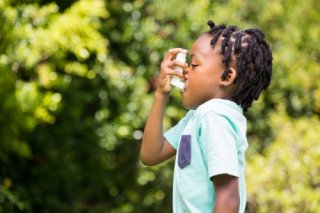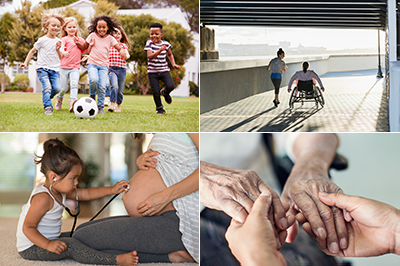Climate Change and Human Health: Who’s Most at Risk?

On this page:
Who's Most at Risk?
All Americans face possible health impacts from climate change. Some people, however, face higher risks than others because of differences in the hazards to which they are exposed, their sensitivity to these hazards, and their ability to adapt (see Figure 1, Determinants of Vulnerability).
It is important to be able to identify who's most at risk or “populations of concern,” which include groups representing people of all ages, living in different places, who interact with their environment in different ways. Figure 2, Examples of Climate Change Vulnerability shows some examples of how certain populations are more vulnerable to health impacts because of differences in their exposure, sensitivity, or ability to adapt to climate-related stresses.
In this web area, explore these pages to learn more about populations expected to face greater risks and impacts from climate-related hazards. Each page highlights actions people can take to reduce climate-related health impacts:

- Children
- Socially Vulnerable People
- Indigenous Populations
- Older Adults
- People with Chronic Medical Conditions
- People with Disabilities
- Workers
- Pregnant, Breastfeeding, and Postpartum Women
The different health impacts described here do not occur in isolation. People can face multiple threats at the same time, at different stages in their lives, or accumulating over the course of their lives. Risks may increase as people are exposed to multiple health threats. For example, extremely hot days can lead to heat-related illness as well as poor air quality, by increasing the chemical reactions that produce smog. In addition, many of the factors that influence whether a person is exposed to health threats or whether they become ill, such as an individual’s personal habits, living conditions, and access to medical care, can also change over time.
Determinants of Vulnerability

Examples of Vulnerability
Exposure
Sensitivity
Ability to Adapt
Low-income populations may be exposed to climate change threats because of socioeconomic factors. For example, people who cannot afford air conditioning are more likely to suffer from unsafe indoor air temperatures.
Pregnant women are sensitive to health risks from extreme weather such as hurricanes and floods. These events can affect their mental health and the health of their unborn babies by contributing to low birthweight or preterm birth.
Older adults may have limited ability to cope with extreme weather if, for example, they have difficulty accessing cooling center or other support services during a heat wave. Heat-related deaths are most commonly reported among adults aged 65 and over.
Occupational groups such as first responders and construction workers face more frequent or longer exposure to climate change threats. For example, extreme heat and disease-carrying insects and ticks particularly affect outdoor workers.
People with pre-existing medical conditions, such as asthma, are particularly sensitive to climate change impacts on air quality. People who have diabetes or who take medications that make it difficult to regulate body temperature are sensitive to extreme heat.
People with disabilities face challenges preparing for and responding to extreme weather events. For example, emergency or evacuation instructions are often not accessible to people with learning, hearing, or visual disabilities.
People in certain locations may be exposed to climate change threats, such as droughts, floods, or severe storms, that are specific to where they live. For example, people living by the coast are at increased risk from hurricanes, sea level rise, and storm surge.
Children are more sensitive to respiratory hazards than adults because of their lower body weight, higher levels of physical activity, and still-developing lungs. Longer pollen seasons may lead to more asthma episodes.
Indigenous people who rely on subsistence food have limited options to adapt to climate change threats to traditional food sources. Rising temperatures and changes in the growing season affect the safety, availability, and nutritional value of some traditional foods and medicinal plants.
Figure 2. Examples of Climate Change Vulnerability, based on the U.S. Global Change Research Program’s 2016 Climate and Health Assessment, provides examples of populations at elevated risk of climate change’s health impacts, organized by determinant of vulnerability.
